What Is Hemp Flower? Benefits, Uses, and Effects Explained
Written by California Blendz
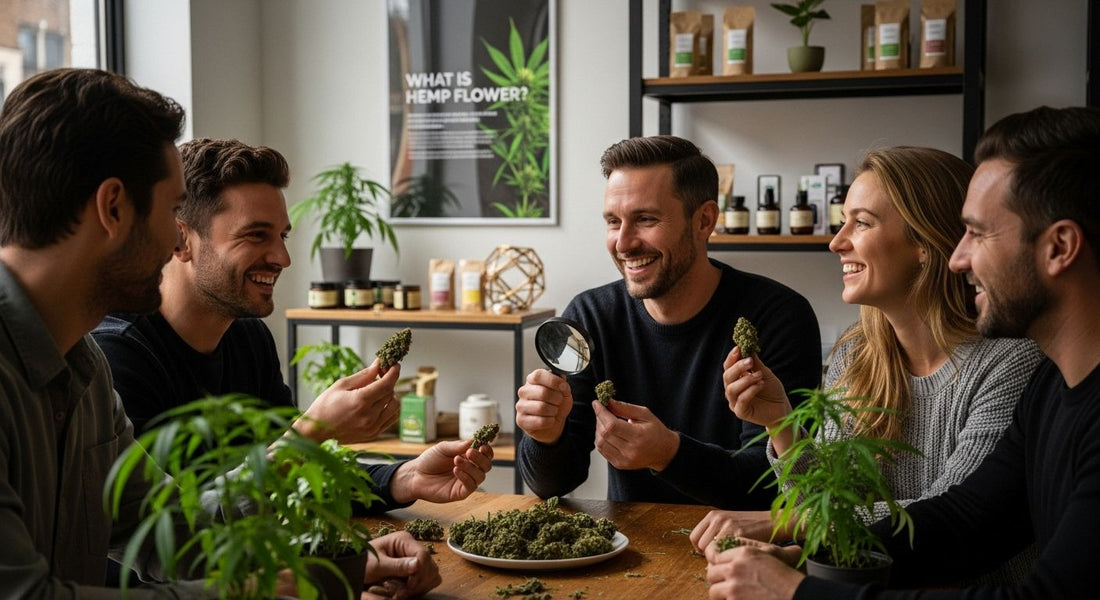
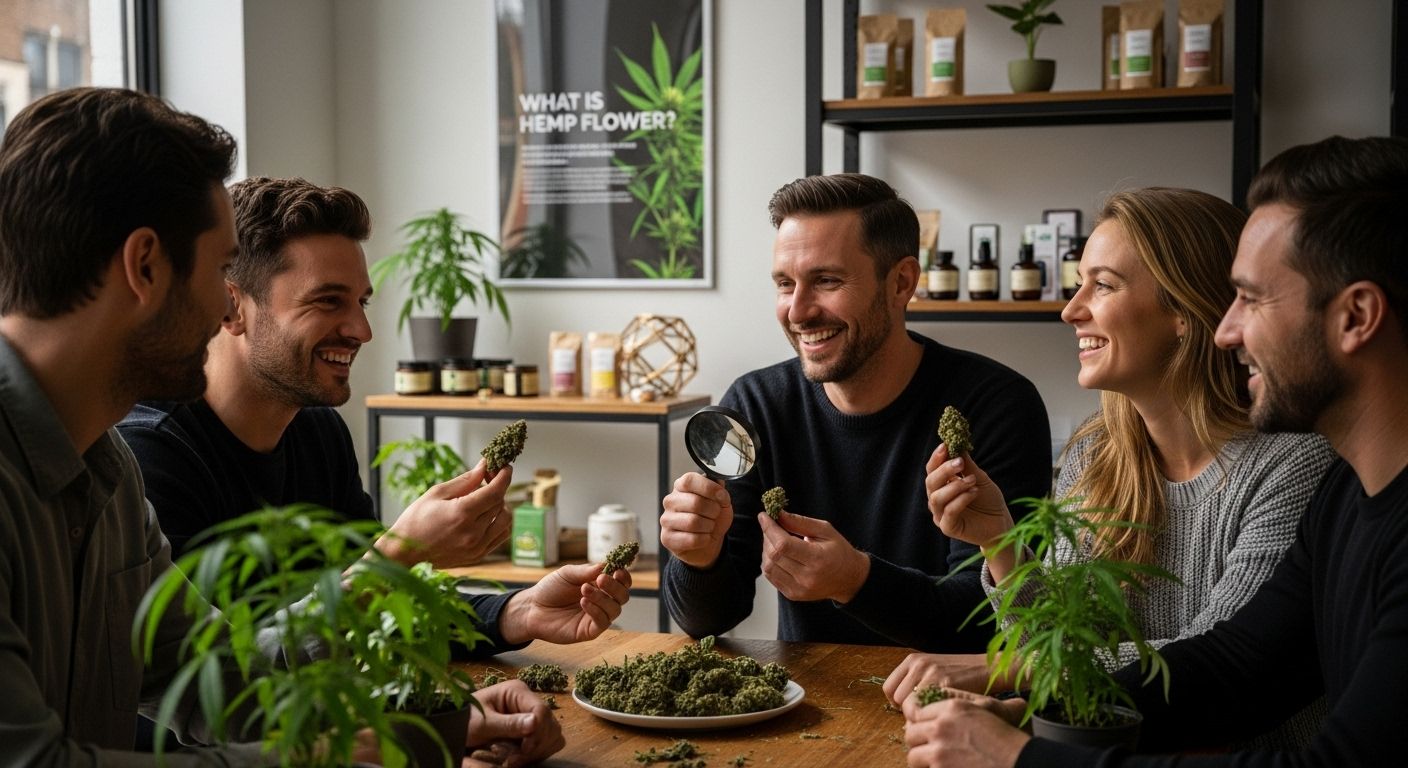
Hemp flower keeps popping up everywhere these days, and the buzz around its natural benefits just keeps growing. Most people are shocked to learn that hemp flower contains less than 0.3% THC by law, making it non-intoxicating and federally legal in the US. Turns out, the real surprise is not about breaking any rules or getting high—the real value lies in the untapped wellness potential and how versatile this plant actually is.
Table of Contents
- Understanding What Is Hemp Flower
- Benefits And Uses Of Hemp Flower
- Hemp Flower Vs Cbd Flower: Key Differences
- Safe Consumption And Legal Considerations
Quick Summary
| Takeaway | Explanation |
|---|---|
| Hemp flower is non-intoxicating | Contains less than 0.3% THC, making it legal and safe for consumption. |
| It offers diverse wellness benefits | Potential uses include pain relief, anxiety reduction, and neuroprotection due to its CBD content. |
| Multiple consumption methods exist | Options include smoking, vaporizing, and incorporating into edibles or oils for varying experiences. |
| Understand legal regulations in your area | Hemp flower legality varies by state; stay informed to avoid legal issues while consuming. |
| Prioritize safe consumption practices | Select lab-tested products, consult healthcare professionals, and start with small doses to ensure safety. |
Understanding What Is Hemp Flower
Hemp flower represents a natural botanical product derived from the Cannabis sativa plant, specifically cultivated for its low THC content and high concentrations of beneficial cannabinoids. Unlike marijuana, hemp flower contains less than 0.3% delta-9 tetrahydrocannabinol, making it a legal and non-intoxicating alternative for wellness seekers.
The Botanical Origins of Hemp Flower
Hemp flower emerges from carefully cultivated Cannabis sativa plants bred specifically to produce minimal psychoactive compounds. These plants are meticulously grown to maximize cannabinoid profiles while maintaining legal compliance. Our comprehensive guide on quality hemp flower offers deeper insights into the nuanced cultivation processes.
According to Cannabis and Cannabinoid Research, hemp flowers are primarily harvested for their rich cannabinoid content, particularly cannabidiol (CBD), which has demonstrated potential therapeutic applications. The plants are strategically bred to emphasize non-intoxicating compounds that support general wellness without producing significant psychoactive effects.
Chemical Composition and Characteristics
Hemp flowers contain a complex array of chemical compounds beyond cannabinoids. These include terpenes, flavonoids, and other phytonutrients that contribute to the plant’s potential wellness benefits. The intricate chemical profile determines the flower’s potential effects and characteristics.
Typically, hemp flowers feature cannabinoid concentrations ranging from 10% to 20% CBD, with trace amounts of other cannabinoids like CBG and CBC. The terpene profile further distinguishes different hemp flower varieties, influencing aroma, flavor, and potential physiological interactions. Each strain offers a unique combination of compounds, creating diverse potential experiences for users seeking natural wellness solutions.
The legal status of hemp flower hinges on its chemical composition. Federal regulations mandate that hemp plants contain less than 0.3% delta-9 THC, ensuring they remain classified as industrial hemp rather than a controlled substance. This regulatory framework has enabled broader research and consumer access to these botanical products, supporting ongoing scientific exploration of their potential benefits.
Benefits and Uses of Hemp Flower
Hemp flower offers a diverse range of potential wellness applications, extending far beyond traditional medical interventions. Its versatile nature allows users to explore multiple consumption methods and potential health support strategies.
Wellness and Therapeutic Potential
Research from the National Institutes of Health reveals compelling evidence about hemp flower’s potential therapeutic properties. The plant demonstrates promising characteristics for addressing various health concerns, including pain management, anxiety reduction, and neurological support. Cannabidiol (CBD) emerges as a primary compound responsible for many of these potential benefits.
Clinical studies suggest hemp flower may provide natural alternatives for individuals seeking relief from chronic conditions. Potential applications include managing inflammation, supporting stress reduction, and promoting overall mental and physical balance. Learn more about CBD-rich hemp flower benefits to understand the comprehensive range of potential wellness support.
Consumption Methods and Applications
Hemp flower can be utilized through multiple consumption methods, each offering unique experiences and potential benefits. Smoking remains a traditional approach, allowing rapid cannabinoid absorption. Vaporization provides a potentially less harmful alternative, heating the flower without combustion. Other methods include creating tinctures, infusing oils, brewing teas, and incorporating hemp flower into culinary preparations.
Beyond personal wellness, hemp flower demonstrates significant potential in areas like natural stress management, sleep support, and holistic health approaches. Users report varied experiences, ranging from mild relaxation to improved focus and potential relief from discomfort. The individualized nature of hemp flower interactions means experiences can differ based on personal biochemistry and specific product characteristics.
The versatility of hemp flower extends to various lifestyle applications. Some individuals incorporate it into meditation practices, while others use it as a potential natural supplement for managing daily stress. Athletes and fitness enthusiasts explore its potential for recovery and inflammation management, highlighting the broad spectrum of potential uses beyond traditional medical frameworks.
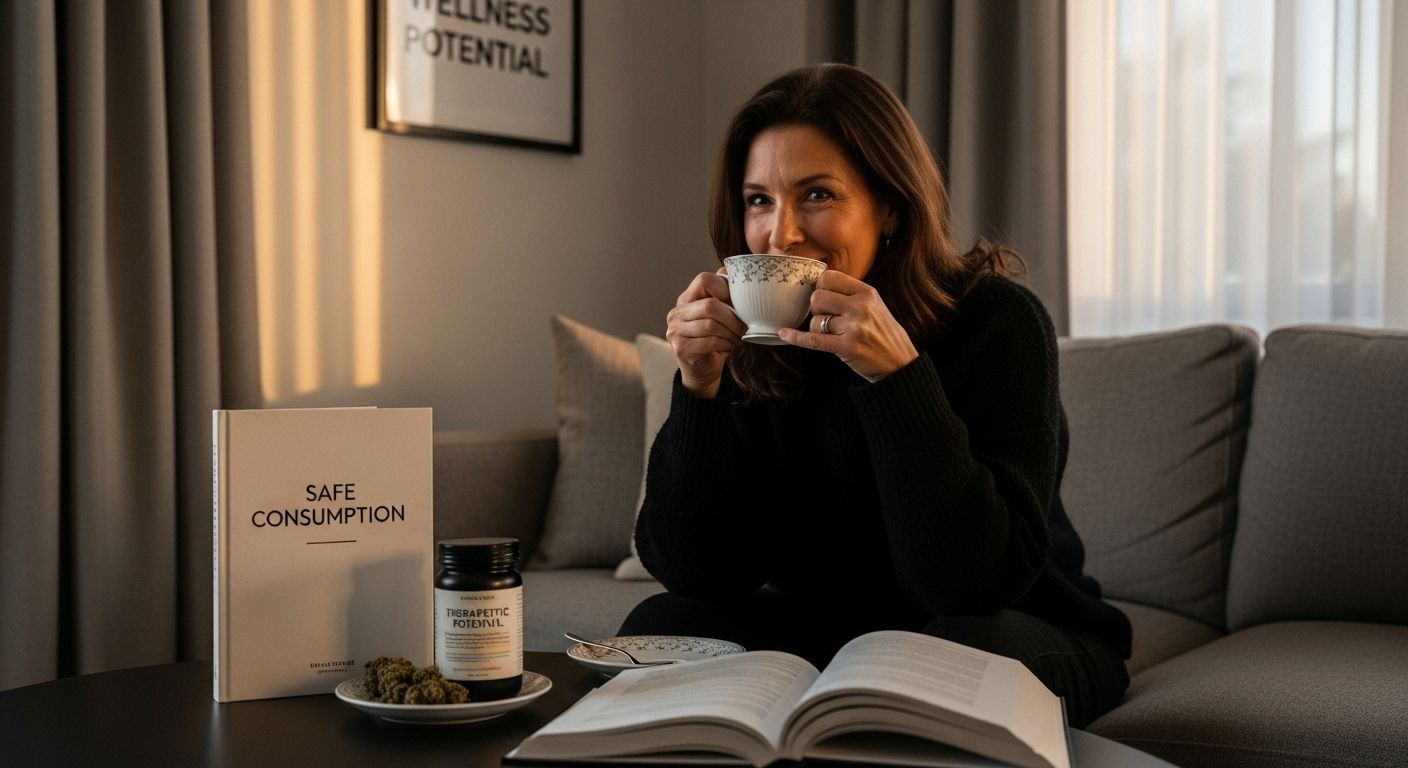
Importantly, while hemp flower shows promising potential, users should approach consumption responsibly. Consulting healthcare professionals, understanding personal health conditions, and selecting high-quality, lab-tested products remain crucial steps in safely exploring hemp flower’s potential benefits.
Hemp Flower vs CBD Flower: Key Differences
Understanding the nuanced differences between hemp flower and CBD flower requires a deep dive into their botanical origins, chemical compositions, and regulatory landscapes. While these terms are often used interchangeably, they represent distinct categories within the cannabis product spectrum.
Botanical and Chemical Composition
Research from North Carolina State University highlights that hemp and marijuana are both varieties of Cannabis sativa, distinguished primarily by their THC content. Hemp contains no more than 0.3% THC, whereas marijuana typically contains 5 to 20% THC. This critical distinction means hemp does not produce psychoactive effects.
According to scientific literature, hemp refers to non-intoxicating, low delta-9 tetrahydrocannabinol cultivars of Cannabis sativa L. CBD flower, while technically a subset of hemp flower, is specifically cultivated to maximize cannabidiol concentrations. Dive deeper into the intricate world of CBD flower myths and facts to understand these subtle yet significant differences.
Legal and Regulatory Considerations
The legal status of hemp and CBD flower hinges on precise chemical profiles and federal regulations. Hemp flower must contain less than 0.3% delta-9 THC to maintain its legal status under federal guidelines. CBD flower, while falling under the hemp category, is often more specifically processed to extract or emphasize cannabidiol content.
From a production perspective, hemp flower may be cultivated for various purposes including textiles, nutrition, and wellness products. CBD flower, conversely, is typically grown with a singular focus on maximizing cannabidiol concentrations. This targeted cultivation means CBD flower often features higher percentages of cannabidiol compared to general hemp flower.
Consumption and Potential Applications
The consumption methods for hemp flower and CBD flower largely overlap, including smoking, vaporization, and creating derivative products like tinctures and oils. However, CBD flower tends to be marketed more explicitly for potential wellness applications, with users seeking specific therapeutic or relaxation effects.
Consumers should recognize that while all CBD flower is hemp flower, not all hemp flower is specifically CBD flower. The distinction lies in intentional cultivation practices, cannabinoid concentration, and targeted consumer markets. Some hemp flowers might have balanced cannabinoid profiles, while CBD flowers are strategically bred to maximize cannabidiol content.
Here’s a comparison table to help clarify the differences and similarities between hemp flower and CBD flower, as discussed in this section.
| Feature | Hemp Flower | CBD Flower |
|---|---|---|
| THC Content | ≤ 0.3% (non-intoxicating) | ≤ 0.3% (non-intoxicating) |
| CBD Content | Moderate to high (varies by strain) | High (specifically cultivated for CBD) |
| Intended Use | Wellness, textiles, nutrition, more | Primarily wellness (CBD-focused) |
| Cultivation Focus | Multiple uses | Maximize cannabidiol (CBD) |
| Common Consumption Methods | Smoking, vaporizing, edibles, oils | Smoking, vaporizing, tinctures, oils |
| Legal Status (US Federal) | Legal if ≤ 0.3% THC | Legal if ≤ 0.3% THC |
| Marketed Benefits | Broad wellness spectrum | Specific therapeutic/relaxation effects |
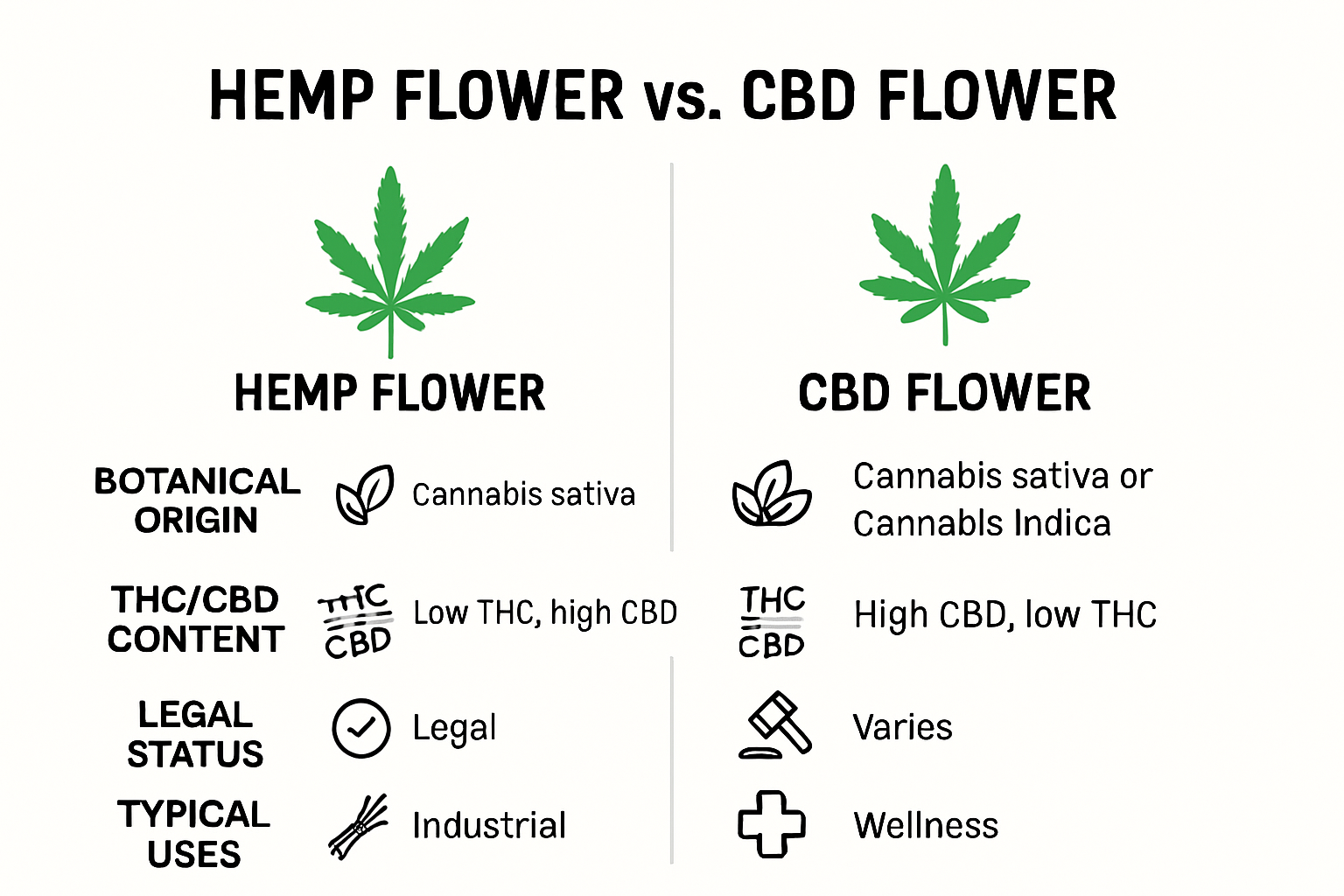
Ultimately, selecting between hemp flower and CBD flower depends on individual wellness goals, legal considerations, and personal preferences. Consulting healthcare professionals and purchasing from reputable, lab-tested sources remains crucial for safe and informed consumption.
Safe Consumption and Legal Considerations
Navigating the complex landscape of hemp flower consumption requires a comprehensive understanding of legal frameworks, potential health implications, and responsible usage guidelines. As the market continues to evolve, consumers must remain informed and cautious about their choices.
Regulatory Landscape and Safety Concerns
A 2023 study published in the Journal of the American Medical Association highlights significant public health concerns surrounding unregulated hemp-derived cannabis products. These products frequently lack essential safety features such as age restrictions, warning labels, and clear dosage instructions, potentially exposing consumers to unexpected risks.
The U.S. Food and Drug Administration has not approved cannabinoids like CBD for use in food or dietary supplements. The agency continues to monitor the market, issuing warning letters to companies making unsubstantiated health claims. This regulatory uncertainty underscores the importance of understanding wellness approaches without compromising safety.
Legal Considerations and State Variations
The legal status of hemp flower remains complex and variable. As of November 2023, regulatory landscapes differ dramatically across states. Some states have implemented strict regulations on hemp-derived products, with 17 states banning delta-8-THC and 7 severely restricting its sale. These inconsistent legal frameworks create challenges for consumers and manufacturers alike.
Federal guidelines mandate that hemp flower must contain less than 0.3% delta-9 THC to maintain legal status. However, state-level regulations can impose additional restrictions or requirements. Consumers must stay informed about local laws and potential legal implications of hemp flower possession and consumption.
Responsible Consumption Strategies
Safe hemp flower consumption requires a multifaceted approach. Key recommendations include purchasing from reputable, lab-tested sources, understanding personal health conditions, and consulting healthcare professionals before incorporating hemp flower into wellness routines.
Potential consumers should consider several critical factors: individual health history, potential medication interactions, personal tolerance, and intended usage goals. Start with low doses, observe individual responses, and prioritize quality over quantity. Third-party lab testing becomes crucial in verifying product potency, purity, and safety.
Special populations such as pregnant individuals, those with pre-existing medical conditions, or individuals taking prescription medications should exercise additional caution. Some cannabinoids may interact with other drugs or impact underlying health conditions.
The following table summarizes safe consumption practices and important legal considerations for hemp flower users, as highlighted in this section.
| Consideration | Recommendation/Detail |
|---|---|
| Purchase Source | Choose reputable, lab-tested brands |
| Dosage | Start with low doses; adjust as needed |
| Health Consultation | Discuss with healthcare professional, especially if on medications |
| Legal Status | Check both federal and your state regulations |
| Labeling & Warnings | Look for products with clear dosage and safety information |
| Special Populations | Pregnant, medicated, or at-risk individuals should use extra caution |
| Third-Party Testing | Verify product potency and purity with lab results |
| Regulatory Compliance | Only purchase products ≤ 0.3% delta-9 THC |
Ultimately, responsible hemp flower consumption demands ongoing education, self-awareness, and a commitment to personal wellness. While hemp flower offers potential benefits, individual experiences can vary significantly. Approach consumption with informed skepticism, prioritize personal health, and remain adaptable as research and regulations continue to evolve.
Frequently Asked Questions
What is hemp flower?
Hemp flower is a botanical product derived from the Cannabis sativa plant, specifically cultivated for its low THC content (less than 0.3%) and high concentrations of beneficial cannabinoids, particularly CBD.
What are the benefits of using hemp flower?
Hemp flower offers diverse wellness benefits, including potential pain relief, anxiety reduction, and neuroprotective effects, primarily due to its cannabinoid content. Users report various experiences ranging from relaxation to improved focus.
How can I consume hemp flower?
Hemp flower can be consumed in multiple ways, including smoking, vaporizing, creating tinctures, infusing oils, or incorporating it into edibles and culinary preparations for diverse experiences.
What is the difference between hemp flower and CBD flower?
While both hemp flower and CBD flower come from the Cannabis sativa plant, hemp flower contains varying concentrations of cannabinoids, whereas CBD flower is specifically cultivated to maximize its cannabidiol (CBD) content, focusing more on wellness applications.
Experience Premium Hemp Flower Solutions for Your Wellness Journey
Looking for high-quality, non-intoxicating hemp flower that truly delivers on relaxation, relief, and peace of mind? If you are tired of uncertainty over product purity or frustrated by inconsistent results from generic brands, we understand your challenges. Our carefully curated CBD Sun Grown collection is designed for those who value lab-tested, organic hemp flower from California’s renowned Emerald Triangle. Each batch offers transparent lab results and clear product descriptions, so you get what you expect every time.
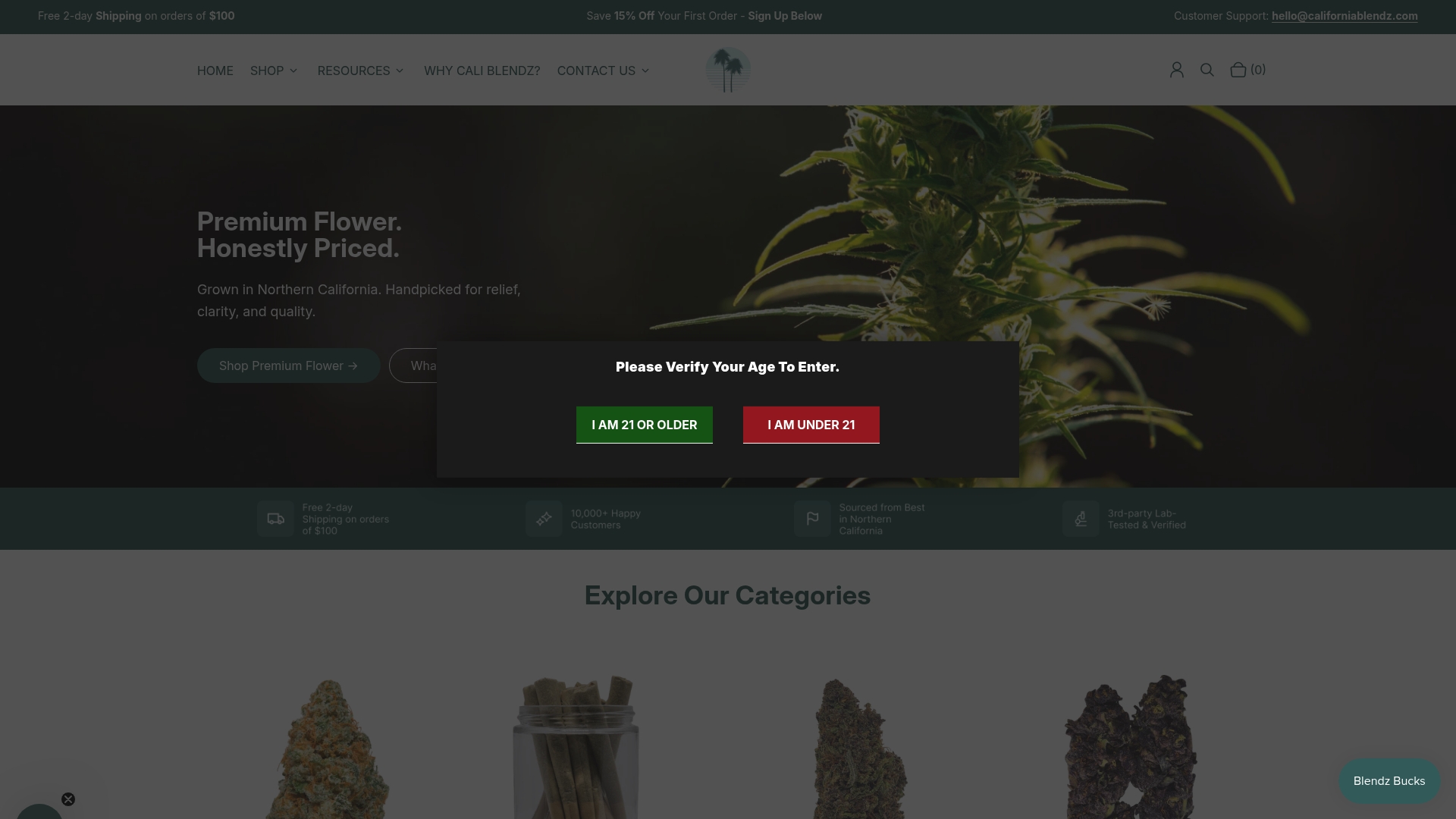
Ready to put knowledge into action? Visit California Blendz now and explore our extensive options for premium, legal hemp flower. Give your wellness routine the boost it deserves by choosing from trusted sources like the CBD Flower Collection. Shop today and take control of your hemp experience with a brand that puts your safety and satisfaction first.
Recommended
- What Is CBD Flower? Benefits, Effects, And How It Differs From THC – California Blendz
- Discover the Benefits and Uses of CBD-Rich Hemp Flower: The Ultimate G – California Blendz
- Discover the Benefits of Relaxing Hemp Flower and How it Can Enhance Y – California Blendz
- How to Find Quality Hemp Flower: A Comprehensive Guide for Buyers – California Blendz








